I have a ton of information for you today on winter squash plants (and why they can be hard to digest) when you have IBS and/or IBD.
You could be sans-bloat, but for some reason the winter squash bush varieties can have your stomach rumbling.
Some of you already know that sweet potatoes leave you feeling gassy. They are not in the winter squash family, but they tend to have similar effects.
So I investigated different varieties of winter squash, aka the wicked winter squash with IBS and IBD.
I am here to share some information.
Winter Squash Plants [and why they can be hard to digest]
Click HERE to save winter squash varieties for later.
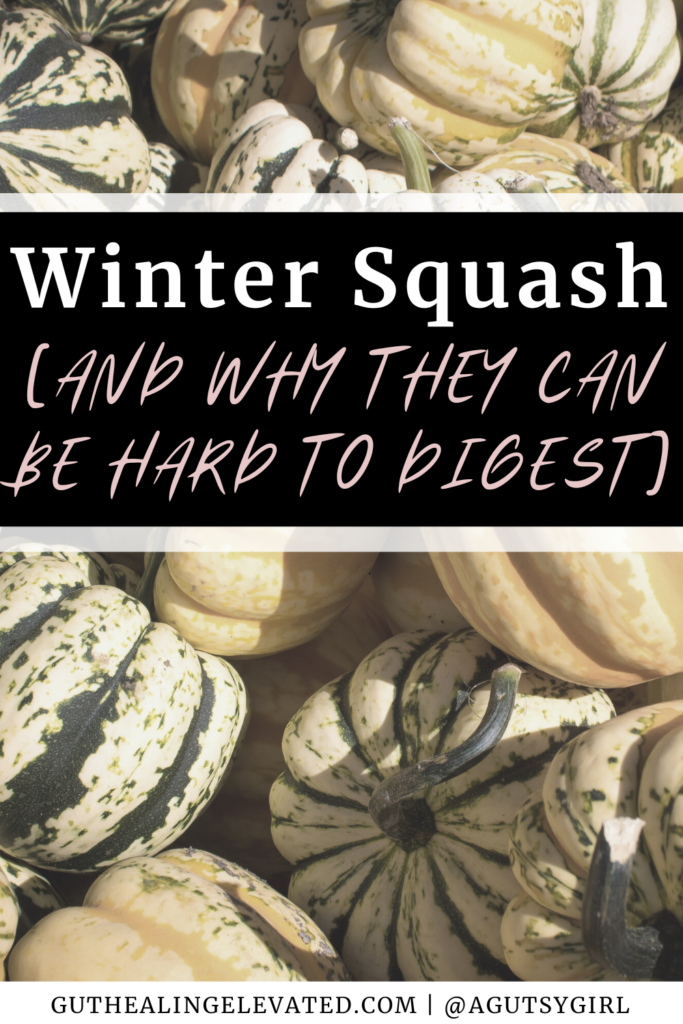
First, let’s make sure you know what winter squash is.
According to The Kitchn, these are the 16 main types you need to know:
- Acorn
- Banana Squash
- Buttercup
- Butternut
- Carnival
- Delicata
- Green kabocha
- Honeynut
- Hubbard
- Red kabocha
- Red kuri
- Spaghetti
- Sugar pumpkin
- Sweet Dumpling
- Turban
- White acorn
What to Know About Winter Squash Plants
Here are 14 facts to know about winter squash:
- Squash is planted in late May to early July (in the southern states).
- They are sensitive to frost, and thus bloom in the late summer to fall – typically before the first frost.
- There are many different varieties, which means they come in all different shapes and sizes.
- Of the list of 16 from above, the most common varieties are: acorn, butternut, pumpkin, and spaghetti.
- They are vine borers or can be grown on a bush and flowers.
- The name comes from the skin that toughens into a hard rind, making them built to sustain the winter months (the rind and squash seeds are typically not eaten, but can be eaten).
- Nutritionally, they are packed with fiber, minerals, carotenes, and vitamin A, with moderate quantities of vitamins B and C.
- They are in the Cucurbitaceae family, which includes cucumbers, melons, pumpkins, and gourds.
- Because they are compact plants, they have also been grown to be used as containers (dried gourds).
- The canned orange stuff that so often becomes pumpkin pie at Thanksgiving? It’s most likely butternut squash.
- Planting time requires full sun at least 6 hours/day, has a long growing season (about 60 – 100 days).
- Winter squash differs from summer squash in that it is harvested and eaten in the mature fruits stage when the seeds within have matured fully and the skin has hardened into a tough rind. At this stage, mature squash can be stored for use during the winter without a lot of space – in a dry place.
- Growing these warm weather plants presents challenges from: cucumber beetles to powdery mildew and other various squash bugs to squash vine borers.
- Summer squashes are harvested before fully maturing, (June through August) giving it a soft, edible skin. While tender and delicious, the delicate exterior gives summer squash a much shorter shelf life. The most common types of summer squash include: zucchini, yellow crookneck squash, yellow straightneck squash, and chayote.
Sources: HERE, HERE, HERE, HERE, and HERE
Starchy Vegetables
And also….winter squashes are starchy vegetables that also contain a higher amount of fiber.
If you are in the gut-healing phase, those two reasons are likely the cause for all that stomach rumbling upon consumption.
Starchy vegetables are, oftentimes, high-quality carbohydrates. This makes them awesome for most people.
As people with IBS or IBD and/or an unknown grumpy gut in general, we are not most people.
A long time ago I told you about bananas, remember? I told you we typically need to eat them super ripened, as unripe fruit has too much starch.

If we’re eating bananas in a way that reduces or eliminates the starch, then it only makes sense that we need to be cognizant of this with all foods.
Both winter squashes and sweet potatoes fall under this starchy vegetable category.
Here are several starchy foods:
- plantain
- yam
- potato
- sweet potatoes (all sorts)
- acorn squash
- butternut squash
- parsnips
- beets
- carrots
- beans (baked, garbanzo, limo, black, kidney, navy, pinto)
- green peas
- lentils
High Fiber Foods
Squashes contain different amounts of fiber.
Here are the fiber contents for the most popular types of squash (as noted from above):
- Acorn: 2.1g of fiber in 1 cup, cubed
- Butternut Squash: 2.8g of fiber in 1 cup, cubed
- Pumpkin: 12g of fiber in 1 cup
- Spaghetti: 1.5g of fiber in 1 cup
While winter squashes typically contain both soluble and insoluble fibers, they are mostly made up of soluble fiber.
[Read: What is the Difference Between Insoluble and Soluble Fiber?]
Remember what I said about fiber? Yes, fiber is amazing. And yes, we eventually want to heal our guts to a place where we can eat a lot of fiber again.
But for now and until we clear away the unwanted bacteria, certain fibers only helps to feed that unwanted bacteria.
Now, to be clear — IF you have been diagnosed with SIBO and are wondering about the FODMAP status of the most popular squashes, here you go….


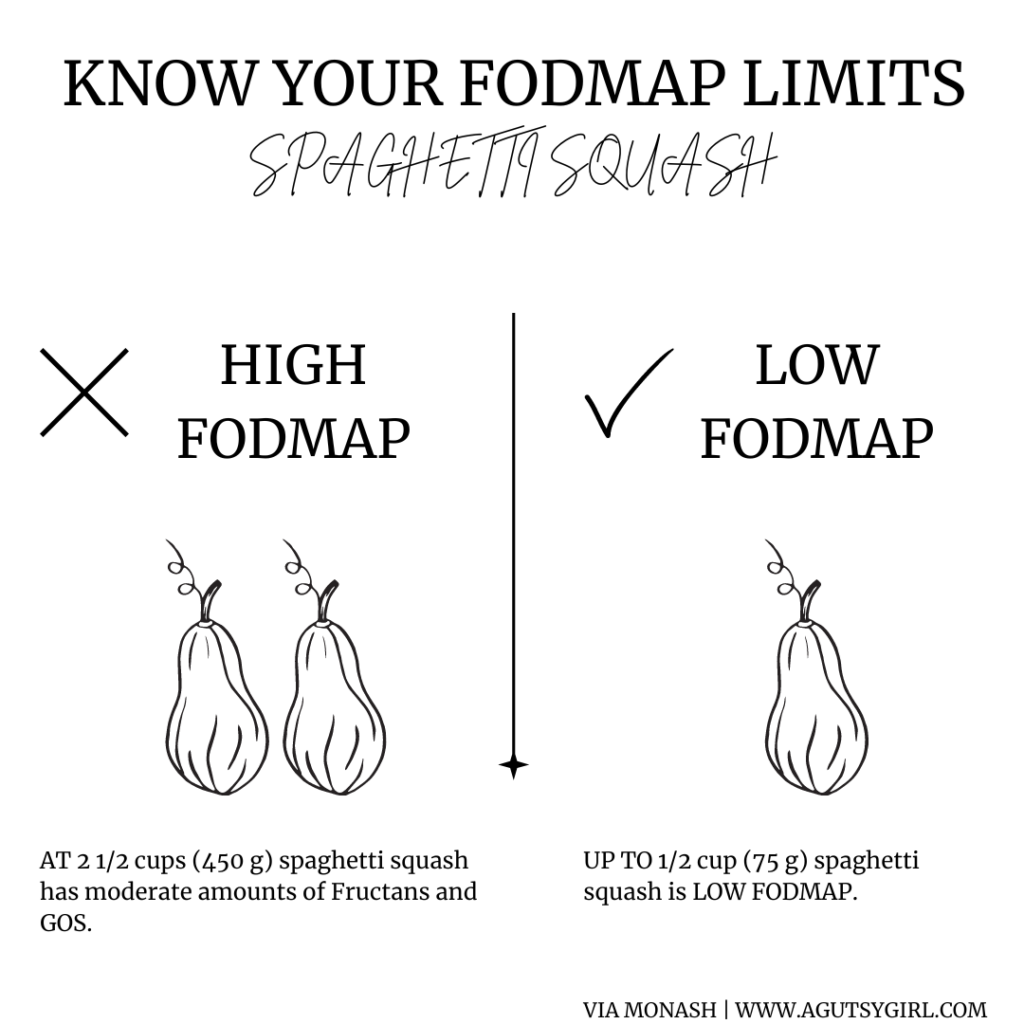
All of these images were taken from Reasonable SIBO, which is my entire guide for the SIBO community. There over 300 graphics like this contained in the master resource. And this is THE guide for you if you have been diagnosed with SIBO and/or think you might have it.
You can get it HERE.
Pumpkin is not in there because it’s a little more nuanced. Here is the FODMAP information for pumpkin:
- Canned pumpkin = low FODMAP
- Sugar pumpkin = high FODMAP
In other words, if you want pumpkin but are watching the FODMAPs, choose canned. And yes, the brown sugar or maple syrup to accompany it is also low-FODMAP (you’re welcome!)
Winter Squash with IBS and IBD
Click HERE to save this information for later.
Gutsy women have a hard time breaking starch down.
Our guts have to work extremely hard to process them into simpler forms. And thus, they stay in the colon longer.
The longer they stay in the colon, the more chance they have at feeding any bad bacteria.
And once again, those awesome starches, which include winter squashes are helping to feed this unwanted bacteria.
What comes next is a grumpy stomach and (usually) some form of stinky-ness.
To be clear, this could also be because the specific winter squash variety eaten was also high-FODMAP. Many varieties of winter squash are high-FODMAP foods.
That stinky-ness was always a classic SIBO symptom for me; it is for many of you, too.
How to: Digest Winter Squash
So, you have SIBO and/or anything else that is causing a lot of bloating and gassiness, but you still want to eat squash.
I get it because I WAS YOU!
You must know, though, that any type of winter squash can present a plethora of problems for the Gutsy women, namely during the intense healing phase.
But here’s the good news: once the gut heals, digesting winter squash should not present these problems and symptoms.
Due to the amount of fiber in winter squash, you could still have some symptoms if you’re eating large amounts in any one sitting.

So here are some ways to better digest winter squash (no matter if you are interested in gut health or you’re in the healing phase):
- Make sure you’re drinking enough water between meals to help keep your system moving. What’s key here is that the water you’re consuming is mostly between vs with meals. You’ll need all the natural digestive enzymes your body produces to help break the squashes down. Consuming a lot of water with your meals prohibits this.
- If you’re in the gut healing vs. health stage, slowly increase fiber. Depending on your gut issues, both/either insoluble and soluble fibers can be difficult to digest. Instead of diving in for 3 cups of squash, start small with 1/4 cup. Listen to your body, evaluate, and move forward. The sweet flesh of squash will be there again tomorrow.
- Use Break Down, the #1 digestive enzyme, to help break the squash down. You only need ONE per meal of this formula as it contains a comprehensive formula designed to support optimal digestion and absorption of essential nutrients. This unique formula contains a proprietary blend of digestive enzymes and betaine hydrochloride (HCl) to support the breakdown of proteins, fats, and carbohydrates.
- Consider what you’re pairing the squash with. Sometimes it’s not the squash in and of itself that poses problems, but instead that you’re mixing it with protein and fats. The trio (protein, carbohydrate, and fat) can be too complex for your digestion right now. Keep it simple.
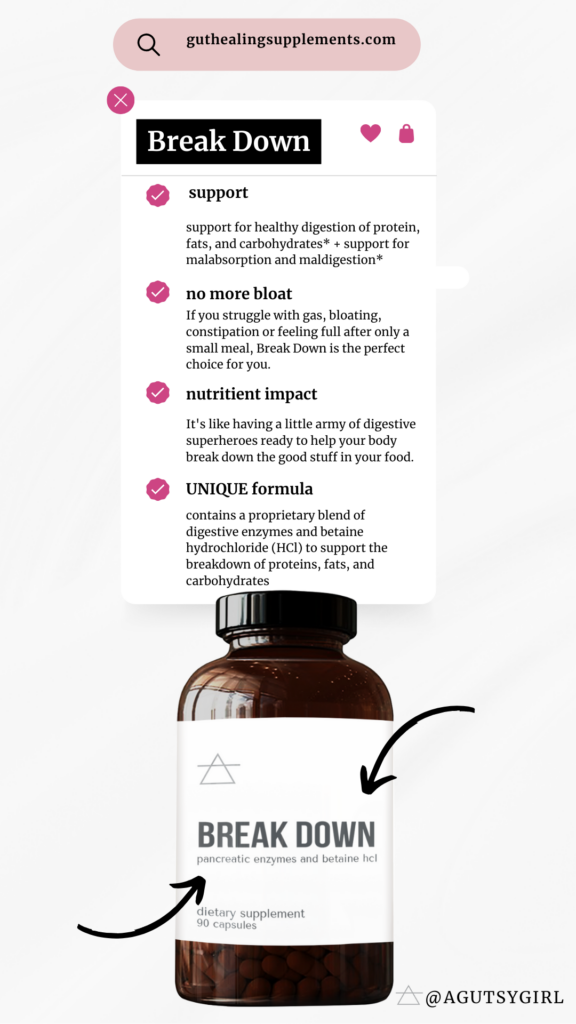
✔ Support for healthy digestion of protein, fats, and carbohydrates*
✔ Support for malabsorption and maldigestion*
Use code AGUTSYGIRL at checkout to save 15% off Break Down.
How to Eat Winter Squash
Personally, I love squash. It used to make me miserable, though, so I don’t pretend like it’s for everyone at each stage of the journey.
I believe the best way to eat it is simply by roasting it in the oven with some olive oil and salt and then just eating it as is.
Let the orange flesh and natural abundance of flavors and textures do their thing without the need for adding much to them.
Here are some winter squash recipe ideas (all of which are gluten and dairy free):
- Lemon Garlic Basil Spaghetti Squash
- Strawberry and Thyme Slow Cooked Spaghetti Squash
- Sweet Potato and Butternut Squash Miso Mash
- Vegan Lemon Lime Cilantro Spaghetti Squash
- Red Quinoa & Butternut Squash Salad with Homemade Sweet Sage Dressing
- Slow-Cooked & Gluten-Free Butternut Squash Chili
- How to Make a Simple Spaghetti Squash
By the way, if you are interested in understanding whether or not it’s working for you, make sure you have your own copy of the 28-day gut healing journaling system so you can track if/how winter squash varieties are affecting you.
If you need to heal your gut so that you never have to worry about eating winter squash again, come join us for all the information you never knew you needed in the 21-Day Quick Gut Detox.
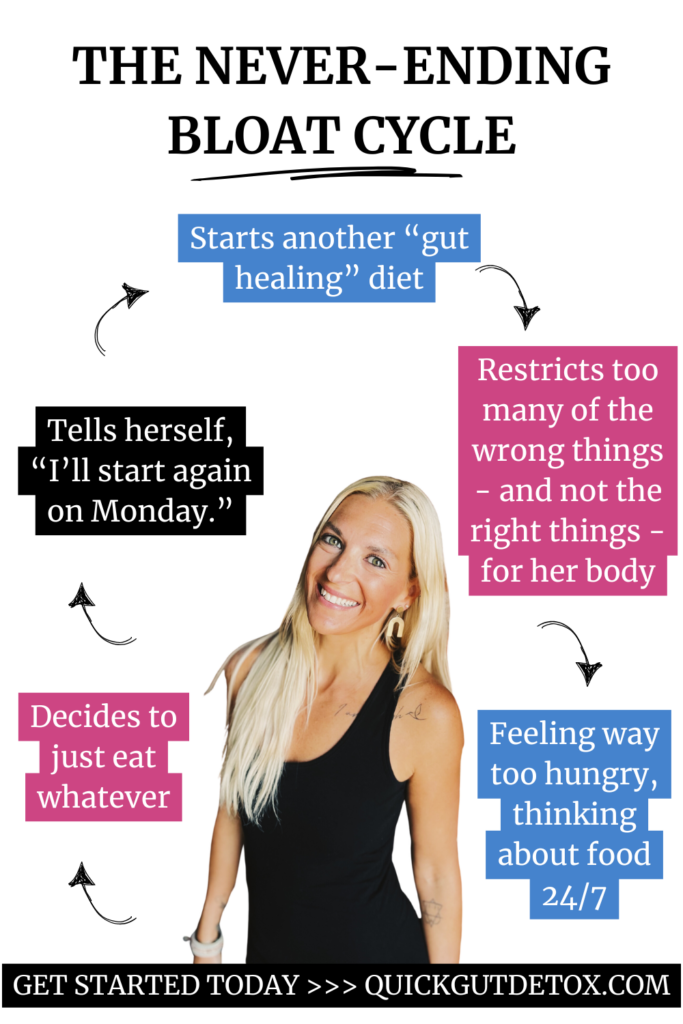
If you liked this post on winter squash varieties, you might also enjoy:
- 5 Reasons Why You Might Not be Able to Digest Sweet Potatoes
- Soluble vs Insoluble Fiber
- 5 Reasons to Heal Your Gut
Xox,
SKH
🤰 bloating be gone! weight loss through optimal gut health for women
💃ʜᴇᴀʟ ʏᴏᴜʀ ɢᴜᴛ. ʜᴇᴀʟ ʏᴏᴜʀ ʟɪfe.
🫶🏻 founder gutbyome.com






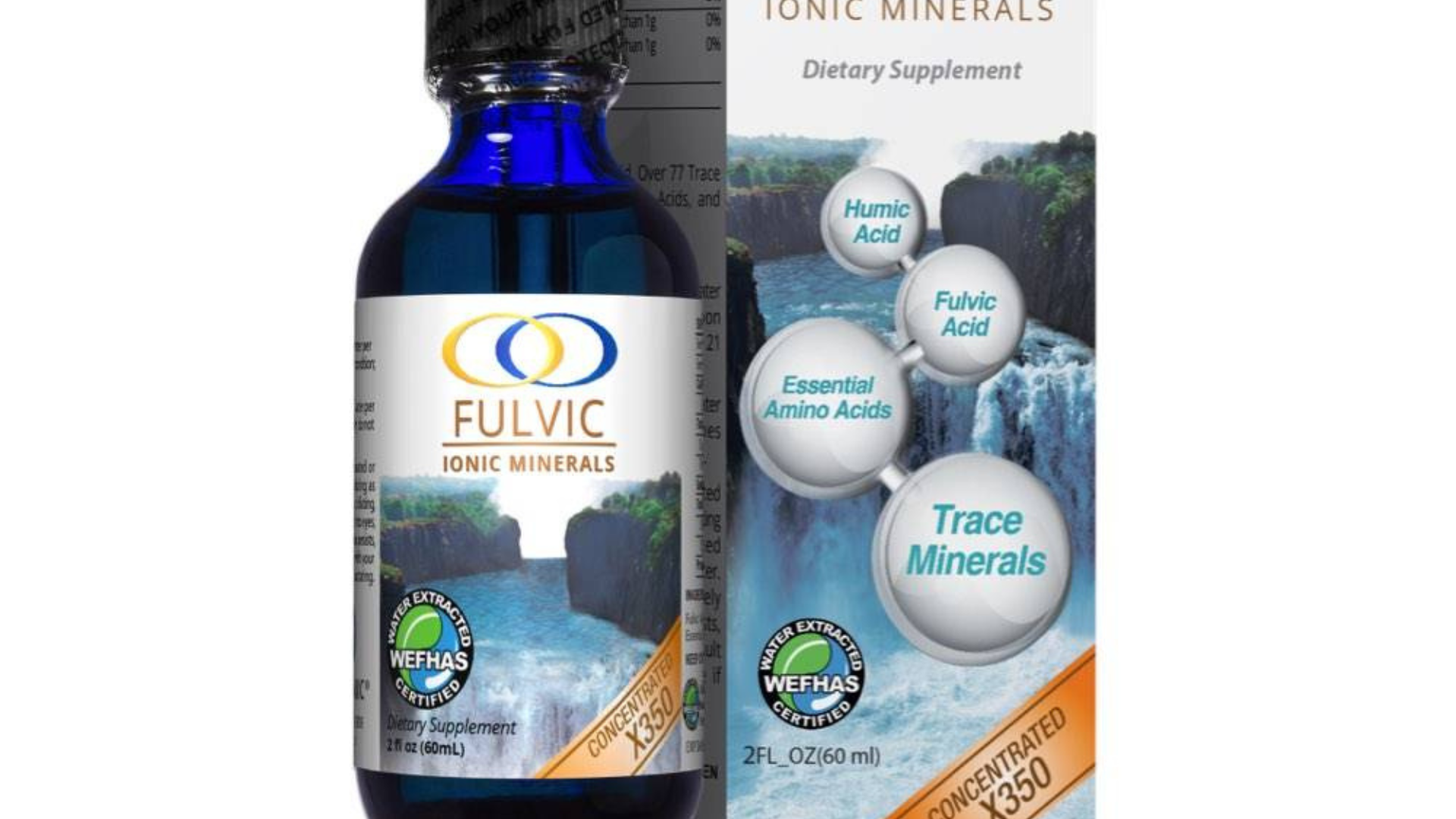
Oh man, I’d be heartbroken too. Happy Healing Girl!
Thanks! Not the end of the world…just something to work towards:)
What food(s) work for you with respect to avoiding starch-iness and still getting carbohydrates? As a marathoner with Crohn’s disease, I have trouble getting enough carbs from whole foods, and just wondering if you have any good ideas!!
Hey Lindsey! I’m a runner, too:) Well…injured, but I’ve trained for many 1/2 marathons! So, what do I eat for carbs? Ones that are super simple to digest. For me, it’s not a ton still. I do a ton of super ripened bananas and raw honey. Beyond that, any vegetables I can tolerate. That’s it. My energy is awesome, and I strongly believe that it’s a myth that in order to nail a 1/2 or full marathon you need to do heavy carb loading. Actually, my friend Chris proved it as well. Read up: http://bit.ly/agugpfmcm Would love to have you join our Mastermind Group. Might help to give you a ton more answers. xo
Love that link! I also eat a paleo-ish diet (I say “ish” because I still love me some PB every now and then, and I occasionally eat yogurt/cheese). But no bread, pasta, processed food for the most part (besides GU gels on runs that are 15+ miles). What is the Mastermind Group?
Mastermind = http://bit.ly/agugmm2
very interesting! i eat only very ripe bananas and i think i am the only one that avoids kabocha. haha. I have tried out delicata and it seems to be okay. Have you tried delicata? Thoughts?
Hey Linds! No, I haven’t tried it yet, but I should…just for fun. It’s a winter squash technically, but in the summer squash family. Many summer squashes I tolerate decently. I might have to give it a try.
I steam mine and add coconut butter. Let me know if you give it a whirl. Now i am just plain curious
I love starchy carbs but clearly they hate me! I still haven’t been able to find a “happy medium” with the foods I eat, so I just suffer through i, whether it’s painful D or painful bloating or anything in between (and trust me, anything goes!)
Bummer….sorry for your pain, too. I was just not willing to live like that anymore. I have hope for the future once I’m healed:)
I just discovered the pitfalls of butternut squash. On my list of “green” (i.e., good-to-go foods), it was actually a “yellow” (be wary). I had about a cup and a half last night. Then I awoke to probably the most painful gas pains in my life (like, about 10 knives stabbing your midsection). I started planning my ER trip as I warmed up my heating pad (while not being able to stand up straight, kinda leaning on the counter top). With the pad and sleep, I woke up without the pain and bloating, but yeesh! It scared me to death. No more squash for me…:(
Really appreciate this post – I wasn’t sure after asking Dr Google about how winter squashes affect those with digestion issues – something I’m playing with myself – this cleared a lot up! Thank you
You are most welcome!
No wonder, thank goodness I came across your site; lately I’ve been trying to include a variety of more veggies in my diet, but butternut squash hit me real hard, and i couldn’t understand why 🙁 i seem to be ok with spaghetti squash and sweet potato, pumpkin not so much. How unfair!
It’s pretty sad:( Happy gut healing!